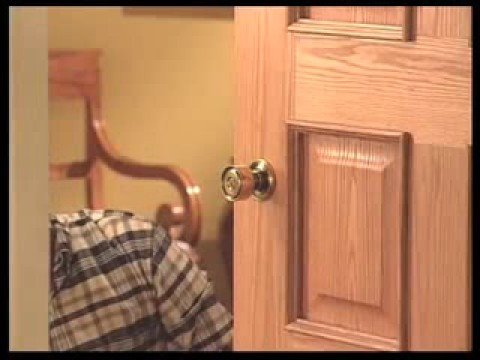Changing Locks on New House – How to Replace
Door locks can be replaced easily as long as you know the type of lock on your door and are sure of your measurements when buying a replacement lockset.
The three major lock types found in most homes are the mortise lock, cylindrical lock and the tubular lock.
Most mortise locks are found on front-entry doors. The lockset usually has a latchbolt and a deadbolt combination in a rectangular box that fits into a recess in the edge of the door. The door must be at least 3.5cm (1 3/8in) thick to accommodate these locks.
To install a mortise lock, make the location for the cylinder hole and spindle using a template (usually provided with the lockset). Drill the holes. Mark the location of the lock body on the edge of the door and drill a series of holes the depth of the lock body into the door edge. Use a chisel to remove the excess wood and then insert the lock body to check for fit. Once the body fits, mark the face plate outline or the edge of the door, remove the lock body and then cut the mortise for the face plate to ensure a flush fit Screw the body into position, attach the handle and knob. The interior knob is usually locked into place with a setscrew.
Mark the strike plate position on the doorjamb. Check to make sure it’s accurate and then chisel the mortise and holes for the latchbolt and deadbolt
Cylindrical locks are inserted through a hole cut in the face of the door and a recess cut in the edge of the door for the latch. The exterior knob has a keyway and the interior knob has a push button to unlock the latch.
To install a cylindrical lock on an old door, remove the old lock and strike plate. Measure the diameter of the cylinder hole and latch hole to ensure that the new lock you buy will be the correct size.
To install a cylindrical lock on a new door, use the template provided with the lockset kit and, with a hole saw, drill the holes in the door face and edge. For the cylinder hole, drill from both door faces into the center to prevent fraying or splitting of the wood. Make sure the hole for the latch is in the center of the door edge and is perpendicular to the cylinder hole.
Insert the latch and with a sharp pencil mark the outline of the face plate on the door. Remove the latch and chisel the mortise, making sure the face plate will sit flush with the surface of the door edge. Screw the latch into position.
Mark the center line of the strike plate on the doorjamb with a vertical and horizontal line to match the center on the latch. Drill a hole at the center point to accept the latch. Line up the strike plate screw holes with the vertical line, making sure the center of the strike plate is in the center of the latch hole you just drilled. Mark the outline of the strike plate on the jamb and cut the mortise with a chisel to ensure a flush fit for the strike plate. Install the strike plate then install the knobs, following the instructions in the lockset kit.
Tubular locks are similar to cylindrical locks, except they’re not as sturdy and do not have a keyway, although some can be locked with a push button. They are used on interior passage doors. Installation of the tubular lock is identical to that of the cylindrical lock.
